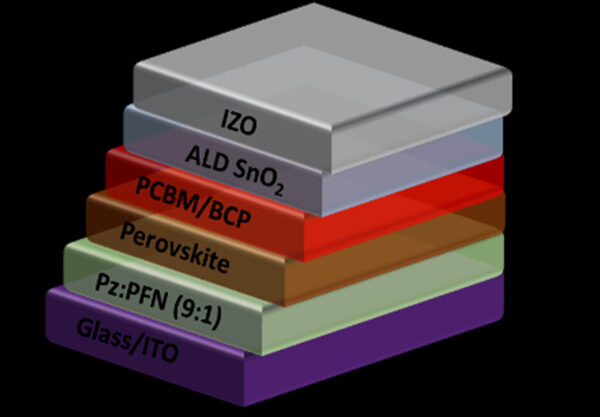Researchers from the Indian Institute of Technology Bombay, Powai Mumbai in India have fabricated an inverted perovskite solar cell based on a hole transport layer (HTL) made of a phosphonic acid called methyl-substituted carbazole (Me-4PACz).
Inverted perovskite cells have a device structure known as “p-i-n”, in which hole-selective contact p is at the bottom of intrinsic perovskite layer i with electron transport layer n at the top. Conventional halide perovskite cells have the same structure but reversed – a “n-i-p” layout.
In n-i-p architecture, the solar cell is illuminated through the electron-transport layer (ETL) side; in the p-i-n structure, it is illuminated through the hole‐transport layer (HTL) surface.
“Our provides an excellent approach to ensure that electronic Fermi-level can be tuned according to absorber layer bandgap and hence will be highly useful for tandem solar cells application,” the research's lead author, Dinesh Kabra, told pv magazine. ” Furthermore, it provides an added advantage of wettability of halide perovskite solution to provide a compact, reproducible and scalable layer. Which is known to be a major challenge for this technology along with stability.”
The scientists explained that the Me‑4PACz HTL is a self-assembled monolayer (SAM) that is able to suppress nonradiative recombination at the interface between the perovskite absorber and the Me‑4PACz layer.
The solar cell has an active area of 0.175 cm2. It is based on a substrate made of glass and indium tin oxide (ITO), an interfacial layer made of the PFN polymer, the Me‑4PACz HTL, the perovskite absorber, an electron transport layer (ETL) made of phenyl-C61-butyric acid methyl ester (PCBM), a bathocuproine (BCP) buffer layer, a tin(IV) oxide (SnO2) layer, and an indium zinc oxide (IZO) transparent conductive oxide film.
Tested under standard conditions, the cell achieved a power conversion efficiency of 20.7%. “To the best of our knowledge, the obtained device efficiency is one of the highest values reported for Me‑4PACz with a triple-cation perovskite composition having a bandgap of 1.6 eV,” the scientists said, noting that the device was able to retain the initial efficiency for 3,000 h.

“We believe that the mixing engineering of the Me‑4PACz SAM with the electrolyte polymer PFN‑Br will not only open new doors to tackle hydrophobic SAMs in solution-processable efficient photovoltaic devices but also allow designing new electrolyte-based polymers and/or small molecules that can be combined with SAMs, thereby quilting a better interface,” the scientists said.
The solar cell was presented in the study “Resolving the Hydrophobicity of the Me-4PACz Hole Transport Layer for Inverted Perovskite Solar Cells with Efficiency >20%,” published in ACS Publications.
This content is protected by copyright and may not be reused. If you want to cooperate with us and would like to reuse some of our content, please contact: editors@pv-magazine.com.




Many perovskite cells are achieving beyond 30 % efficiency in labs in the west and in China… Don’t see what the fuss is about this… It’s only at 20%